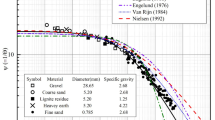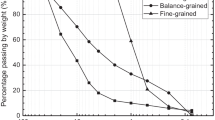Abstract
Depth-averaged method (DAM) is one of the widely used numerical methods to back analyse the post-failure deposits of submarine landslides due to its high efficiency. However, its simplifications of the velocities along the thickness of the slide cannot capture complex behaviours such as shear band propagation. A novel non-averaged method, material point method (MPM), is used to validate the DAM analysis. The runout distances and morphologies of viscous debris flows predicted by the DAM and MPM are compared with those predicted by experiments and computational fluid dynamics analyses. The ranges of the shear strength, viscosity and sensitivity parameters are investigated to determine the feasibility of the DAM. The conventional DAM algorithm specialised for no-slip bases is enhanced to reproduce the phenomenon of block sliding of slides on frictional bases by considering the stability of the front and rear faces. Then, a spreading of horsts and grabens due to shear band propagation is presented with the MPM analysis. Two real cases of submarine landslides, Southern Mediterranean slide and Finneidfjord slide, were back-analysed with the DAM and MPM.














Similar content being viewed by others
Change history
10 January 2020
The published version of this article, unfortunately, contained error. Figure 3 of “GPU-hosted workstation for parallel computing” was lost. Then the sequences of the Figures 4-10 were wrong. Given in this article are the correct figures.
References
ANSYS (2011) ANSYS FLUENT 14.0 theory guide, ANSYS, Inc. v.14.0.1.
Best AI, Clayton CRI, Longva O, Szuman M (2003) The role of free gas in the activation of submarine slides in Finneidfjord. In: Submarine mass movements and their consequences. Springer, Dordrecht, pp 491–498
Bernetti R, Titarev VA, Toro EF (2008) Exact solution of the Riemann problem for the shallow water equations with discontinuous bottom geometry. J Comput Phys 227:3212–3243
Bonet J, Kulasegaram S (2000) Correction and stabilization of smooth particle hydrodynamics methods with applications in metal forming simulations. Int J Numer Methods Eng 47(6):1189–1214
Boukpeti N, White DJ, Randolph MF, Low HE (2012) Strength of fine-grained soils at the solid-fluid transition. Géotechnique 62(3):213–226
Bryn P, Berg K, Forsberg CF, Solheim A, Kvalstad TJ (2005) Explaining the Storegga slide. Mar Pet Geol 22(1-2):11–19
Cai WM, Murti V, Valliappan S (1990) Slope stability analysis using fracture mechanics approach. Theor Appl Fract Mech 12(3):261–281
Collins BD, Sitar N (2011) Stability of steep slopes in cemented sands. J Geotech Geoenviron 137:43–51
De Blasio FV, Engvik L, Harbitz CB, Elverhøi A (2004) Hydroplaning and submarine debris flows. J Geophys Res 109(C1):1–15
De Blasio FV, Elverhøi A, Issler D, Harbitz CB, Ilstad T, Bryn P, Lien R (2005) On the dynamics of subaqueous clay rich gravity mass flows – the giant Storegga slide, Norway. Mar Pet Geol 22:179–186
Dey R, Hawlader B, Phillips R, Soga K (2016) Numerical modeling of submarine landslides with sensitive clay layers. Géotechnique 66:454–468
Dong Y, Grabe J (2018) Large scale parallelisation of the material point method with multiple GPUs. Comput Geotech 101:149–158
Dong Y, Wang D, Randolph MF (2015) A GPU parallel computing strategy for the material point method. Comput Geotech 66:31–38
Dong Y, Wang D, Randolph MF (2017a) Runout of submarine landslide simulated with material point method. In A Rohe, K Soga, H Teunissan & B Zuada Coelho (eds), Procedia Engineering, 175:357–364, 1st International Conference on the Material Point Method, Delft, Netherlands
Dong Y, Wang D, Randolph MF (2017b) Investigating of impact forces on pipeline by submarine landslide using material point method. Ocean Eng 146:21–28
Einav I, Randolph MF (2005) Combining upper bound and strain path methods for evaluating penetration resistance. Int J Numer Methods Eng 63(14):1991–2016
Færseth RB, Sætersmoen BH (2008) Geometry of a major slump structure in the Storegga slide region offshore western Norway. Nor Geol Tidsskr 88(1):1–11
Gauer P, Kvalstad TJ, Forsberg CF, Bryn P, Berg K (2005) The last phase of the Storegga Slide: simulation of retrogressive slide dynamics and comparison with slide-scar morphology. Mar Pet Geol 22(1):171–178
Gue CS, Soga K, Bolton MD, Thusyanthan NI (2010) Centrifuge modelling of submarine landslide flows. In Proceedings of the 7th International Conference on Physical Modelling in Geotechnics 2010, ICPMG 2010, (2), pp 1113–1118
Guilkey J, Harman T, Luitjens J et al (2012) Uintah code (Version 1.5.0). Computer program; available at http://www.uintah.utah.edu. Accessed 05.10.2015
Hampton MA, Lee HJ, Locat J (1996) Submarine landslides. Geophysics 34(1):33–59
Highland L, Peter TB (2008) The landslide handbook: a guide to understanding landslides. US Geological Survey, Reston
Huang X, García MH (1997) A perturbation solution for Bingham-plastic mudflows. J Hydraul Eng 123(11):986–994
Ilstad T, De Blasio FV, Elverhøi A, Harbitz CB, Engvik L, Longva O, Marr JG (2004) On the frontal dynamics and morphology of submarine debris flows. Mar Geol 213(1):481–497
Imran J, Harff P, Parker G (2001) A numerical model of submarine debris flow with graphical user interface. Comput Geosci 27(6):717–729
Iverson RM, Denlinger RP (2001) Flow of variably fluidized granular masses across three-dimensional terrain: 1. Coulomb mixture theory. J Geophys Res 106:537–552
Jassim I, Stolle D, Vermeer P (2013) Two-phase dynamic analysis by material point method. Int J Numer Anal Methods Geomech 37:2502–2522
Jiang L, LeBlond PH (1993) Numerical modelling of an underwater Bingham plastic mudslide and the waves which it generates. J Geophys Res 98(C6):10,303–10,317
Krone RB, Wright VG (1987) Laboratory and numerical study of mud and debris flow. In: Report 1 and 2 for Department of Civil Engineering. University of California, Davis
Leveque RJ (2002) Finite volume methods for hyperbolic problems. Cambridge University Press, Cambridge
Leynaud D, Sultan N, Mienert J (2007) The role of sedimentation rate and permeability in the slope stability of the formerly glaciated Norwegian continental margin: the Storegga slide model. Landslides 4:297–309
Locat J, Lee HJ (2005) Subaqueous debris flows. In: Debris-flow hazards and related phenomena. Springer, Berlin Heidelberg, pp 203–245
Longva O, Janbu N, Blikra LH, Bøe R (2003) The 1996 Finneidfjord slide seafloor failure and slide dynamics. In: Submarine mass movements and their consequences. Springer, Dordrecht, pp 531–538
Luna BQ, Remaitre A, van Asch TWJ, Malet JP, van Westen CJ (2012) Analysis of debris flow behavior with a one dimensional run-out model incorporating entrainment. Eng Geol 128:63–75
Ma J, Wang D, Randolph MF (2014) A new contact algorithm in the material point method for geotechnical simulations. Int J Numer Anal Methods Geomech 38(11):1197–1210
Malet JP, Maquaire O, Locat J, Remaȋtre A (2004) Assessing debris flow hazards associated with slow moving landslides: methodology and numerical analyses. Landslides 1:83–90
Norem H, Locat J, Schieldrop B (1990) An approach to the physics and the modelling of submarine landslides. Mar Georesour Geotechnol 9:93–111
Pasculli A, Minatti L, Sciarra N, Paris E (2013) SPH modeling of fast muddy debris flow: numerical and experimental comparison of certain commonly utilized approaches. Ital J Geosci 132(3):350–365
Pasculli A, Minatti L, Sciarra N (2014) Insights on the application of some current SPH approaches for the study of muddy debris flow: numerical and experimental comparison. Proceedings of 10th International Conference on Advances in Fluid Mechanics, A Coruña, Spain, 82, pp 3–14
Pastor M, Haddad B, Sorbino G, Cuomo S, Drempetic V (2009) A depth-integrated, coupled SPH model for flow-like landslides and related phenomena. Int J Numer Anal Methods Geomech 33:143–172
Puzrin AM, Gray TE, Hill AJ (2017) Retrogressive shear band propagation and spreading failure criteria for submarine landslides. Géotechnique 67(2):95–105
Sahdi F, Gaudin C, White DJ (2014) Strength properties of ultra-soft kaolin. Can Geotech J 51:420–431
Savage SV, Hutter K (1991) The dynamics of avalanches of granular materials from initiation to runout. Part 1: analysis. Acta Mech 86:201–223
Skempton AW, Northey RD (1952) The sensitivity of clays. Géotechnique 3(1):30–53
Soga K, Alonso E, Yerro A, Kumar K, Bandara S (2016) Trends in large-deformation analysis of landslide mass movements with particular emphasis on the material point method. Géotechnique 66(3):1–26
Sulsky D, Zhou SJ, Schreyer HL (1995) Application of a particle-in-cell method to solid mechanics. Comput Phys Commun 87(1):236–252
Wang D, Randolph MF, White DJ (2011) A parametric study of submarine debris flows using large deformation finite element analysis. The VI report for the JIP project modelling of submarine slides and their impact on pipelines from Minerals and Energy Research Institute of Western Australia, Project No. M395
Wang D, Randolph MF, White DJ (2013) A dynamic large deformation finite element method based on mesh regeneration. Comput Geotech 54:192–201
Zhang W, Randolph MF, Puzrin AM, Wang D (2019) Transition from shear band propagation to global slab failure in submarine landslides. Can Geotech J in press
Acknowledgements
Dr Spinewine Benoit from Fugro GeoConsulting and Dr Sam Ingarfield from Fugro AG. are acknowledged for kindly providing the geological information of the submarine landslide in southern Mediterranean and valuable suggestions in its back-analysis.
This work is also supported by NVIDIA Corporation with the donation of the GPU Geforce Titan Xp for this research.
Author information
Authors and Affiliations
Corresponding author
Additional information
The published version of this article, unfortunately, contained error. Figure 3 of “GPU-hosted workstation for parallel computing” was lost. Then the sequences of the Figures 4-10 were wrong. Given in this article are the correct figures.
Rights and permissions
About this article
Cite this article
Dong, Y., Wang, D. & Cui, L. Assessment of depth-averaged method in analysing runout of submarine landslide. Landslides 17, 543–555 (2020). https://doi.org/10.1007/s10346-019-01297-2
Received:
Accepted:
Published:
Issue Date:
DOI: https://doi.org/10.1007/s10346-019-01297-2




